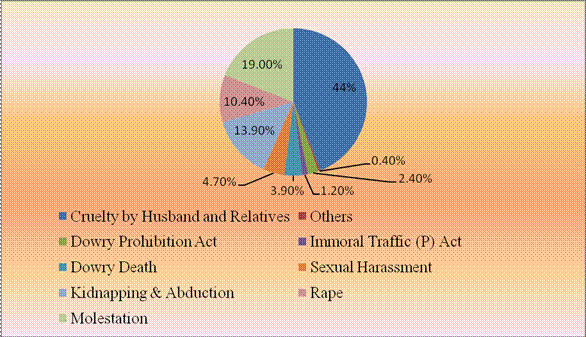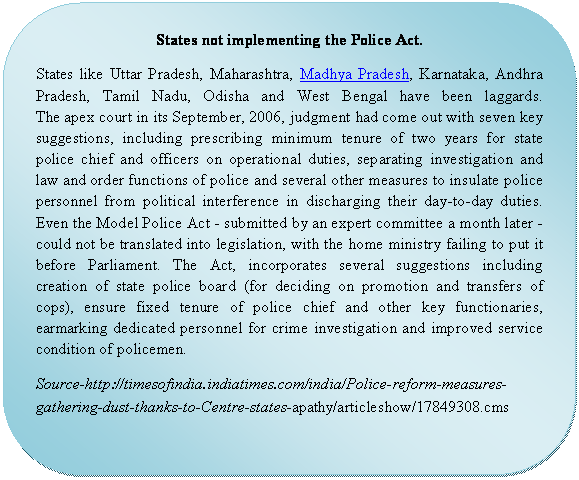Crime Against Women In India
By Ajay Kumar Ranjan
30 January, 2013
Countercurrents.org
“A society that is unable to respect, protect and nurture its women and children loses its moral moorings and runs adrift.” (The Hindu- Opinion Sept, 15 2012 )
Introduction:
Centuries have come, and centuries have gone, but the plight of women is not likely to change. T ime has helplessly watched women suffering in the form of discrimination, oppression, exploitation, degradation, aggression, humiliation . In Indian society, woman occupies a vital position and venerable place. The Vedas glorified women as the mother, the creator, one who gives life and worshipped her as a ‘Devi' or Goddess. But their glorification was rather mythical for at the same time, in India women found herself totally suppressed and subjugated in a patriarchal society. Indian women through the countries remained subjugated and oppressed because society believed in clinging on to orthodox beliefs for the brunt of violence—domestic as well as public, Physical, emotional and mental . Male violence against women are worldwide phenomenon. Fear of violence is an important factor in the lives of most women. Fear of violence is the cause of lack of participation in every sphere of life. There are various forms of crime against women. Sometimes it is even before birth, some times in the adulthood and other phrases of life. In the Indian society, position of women is always perceived in relation to the man. This perception has given birth to various customs and practices. Violence against women both inside and outside of their home has been a crucial issue in the contemporary Indian society. Women in India constitute near about half of its population and most of them are grinding under the socio-cultural and religious structures. One gender has been controlling the space of the India 's social economic, political and religious fabric since time immemorial. The present study felt the need that in the era of globalization and modernization the present trends of crimes against women is on increase. Recently the brutal gang rape against 23 year student in Delhi again sparked the debate on Indian mental set up and existing law and order in the Country.
Various legislation for safeguarding the women:
There are various legislation has been incorporated regarding the safeguarding of the women. Various Legislation for safeguarding crime against women, classified under two categories:
The Crime under Indian Penal Code (IPC):
i. Rape (Section 376 IPC)
ii. Kidnapping and abduction for specified purpose (Section 363-373 IPC)
iii. Homicide for dowry, Dowry death or their attempts. (Sec. 302/304-B IPC)
iv. Torture both mental and physical (Sec.498-A –IPC)
v. Sexual Harassment (Sec. 509 IPC)
vi. Importation of girls (Up to 21 years of age ) (Sec. 366-B IPC)
1. The Crimes under the Special and local Laws (SLL)- Gender specific laws
i. Immoral Traffic (Prevention) Act, 1956.
ii. Dowry Prohibition Act, 1961
iii. Indecent Representation of Women (Prohibition) Act, 1986.
iv. Commission of Sati (Prevention) Act, 1987.
Another danger in India is that, Indian law does not differentiate between major and minor rape. Rape in India has been described by Radha Kumar as one of the “ India 's most common crime against women.” 1 Rape cultures are nourished by norms, attitudes, and practices that trivialize, tolerate, or even condone violence against women. They are further normalized if there is impunity for perpetrators either due to a lack of effective legal mechanisms or apathy to prosecuting crimes against women. The need for a new law on sexual assault was felt as the present law does not define and reflect the various kinds of sexual assault that women are subjected to in our country. The Supreme Court in Sakshi vs. union of India (on 26 th may 2004) had recognized the inadequacies in the law relating to rape and had suggested that the legislature should bring about the required changes.
Incidence and rate of Cognizable Crimes (IPC) and % change during the years:
Crime head |
2001 |
2006 |
2007 |
2008 |
2009 |
2010 |
Rape (Section 376 IPC) |
16075 (1.6%) |
19348 (1.7%) |
20737 (1.8%) |
21467 (1.9%) |
21397 (1.8%) |
22172 (1.9%) |
Source: Crimes In India , National Crime record Bureau, GOI, 2011, 2
“In 2010 there were 22,193 victims of Rape out of 22,172 reported cases in the country. 8.9% (1,975) of the total victims of Rape were girls under 14 years of age, while 16.1% (3,570) were teenage girls (14-18 years). 57.4% (12,749) were women in the age-group 18-30 years. 3,763 victims (17.0%) were in the age-group of 30-50 years while 0.6% (136) was over 50 years of age .” 3
Crime against women Percentage Distribution during 2010.

Source: Crimes In India , NCRB, 2011, 4
Proportion of Crime against women (IPC) towards total IPC crimes.
S.no |
Year |
Total IPC crime |
Crime against women (IPC cases) |
% to total IPC cases. |
1. |
2006 |
18,78,293 |
1,54,158 |
8.2 |
2. |
2007 |
19,89,673 |
1,74,921 |
8.8 |
3. |
2008 |
20,93,379 |
1,86,617 |
8.9 |
3. |
2009 |
21,21,345 |
2,03,804 |
9.2 |
4. |
2010 |
22,24,831 |
2,13,585 |
9.6 |
Source- Crimes in India , 2011, National Crime Record Bureau. 5
As per the above data crime rate trend analysis against women in India shows clearly the sharp increased crime rate from (8.2%) in 2006 to (9.6 %) in 2010 in the last five years. which is a serious matter from the safety and security point of Indian women.
Crimes against women in Cities:
Crimes rates are much higher in big cities than in either small cities or rural areas. “There is a litany of theory about the connection between cities and crime. Indeed some of the most important of the ideas on crime and cities has been discussed at early stages of modern Sociology by Emile Durkheim, George Simmel and Max weber. Wirth (1938) claims that urban crime reflects the more anonymous and unstable nature of urban life. Jacob (1961) focuses on the emptiness of urban streets, and argue that cities only abet crimes when urban neighborhood lose ( as they often do) their traditional social structure.” 6 A study conducted by NAVTEQ in 2011 (global provider of navigation enabled maps) regarding safety of women in Delhi reveals that, 51 percentages of the women surveyed in Delhi, Kolkata, and Chennai felt unsafe while travelling on roads while 73 % said that they were scared of travelling at night. TNS Market Research claims 87 per cent women regarded Delhi as most unsafe city while Mumbai was touted as the safest city by 74 per cent women.
There are some of the bright ideas have been given but they are still remaining in the papers:
Date |
Ideas |
25 th April 2008 |
Reception hostel to be set up in each district as transit accommodation for women in distress. |
5 th Feb. 2009 |
Women Constable to be deployed in slums and areas near lacking civic amenities. They should interact with women and identify habitual /potential harassers /molesters to take preventive action. |
28 th May 2009 |
Action be taken against stalkers of women like making them sign a bond pledging good behavior. |
11 th June 2009 |
Patrolling by women constable /officers in slum and other congested areas should be intensified. |
22 nd Oct 2009 |
Delhi Police commissioner should write to transport commissioner advising that antecedents of all drivers of public service vehicles must be verified by police. Drivers should also carry biometric photo ID. |
22 nd Dec.2010 |
Constable should be posted at bus stops to instill a sense of security in women commuters. |
28 th Oct 2011 |
All DTC bus stops in DU's North and South Campuses should be covered by police. |
Source –Times of India .
“As public outrage grows against the heinous incident of rape in Delhi and the parliament discusses the issue, a report has revealed that there are several lawmakers who have similar cases pending against them as per their last affidavit declaration to the ECI. Even larger number of such people has been given tickets by political parties to contest elections in the last five years. The report was released on Thursday by Association for Democratic Reforms (ADR) and National Election Watch (NEW) who looked at the background of lawmakers (MPs and MLAs) with respect to rape cases and other crimes against women based on their affidavits. According to the report, six MLAs have declared that they have charges of rape against them in their sworn affidavits submitted to the Election Commission of India at the time of their election. Besides, 36 other MLAs have declared that they have other charges of crimes against women such as outraging the modesty of a woman, assault, and insulting the modesty of a woman. Out of these 27 candidates who declared rape charges, 10 are from UP and 5 are from Bihar . The political parties also gave tickets to 260 other contesting candidates in the legislative assembly elections held in the last five years who have declared that they have charges of crimes against women.” ( http://timesofindia.indiatimes.com/city/varanasi/Crimes-against-women-Cases-pending-against-lawmakers/articleshow/17701369.cms )
Approach towards safety of women:
1• To increase reporting of rape and assault cases: To increase the reporting of such cases at first we need to empower the women and children. They must be educate on their rights and encourage them to come forward to register the cases. There are many violent cases but due to stigma in the society very few are reported.
2• Law enforcement agencies: Low enforces should be well trained to react swiftly and with sensitivity towards the women and children cases.
3• Exemplary punishment: Punishment of every culprit need to be exemplary. Campaigning of “Zero- tolerance” of sex offenders. More and more fast track court should establish.
4• Proper planning of the city: Every city should be planned in a very specific manner. According to Ranjana Kumari, director of Delhi 's Centre for Social Research, only 37% of the city was ever planned. "The rest is . . . slums, villages, with no proper lighting or development," she said last week. "There are many pockets of crime."
5• Indian Police system: Neither the Centre nor States have been proactive in improving the quality of Policing. Official records shows that only 14 states have either enacted the New Police Act or amended their existing laws to incorporate SC's suggestion.

Finally, a nationwide campaign is needed to reignite India 's core values and traditions that respect and nurture women and children. This can only be borne out of consensus in society. Awareness amongst men of the scope of this issue is critical. Men who turn a blind eye to such brutal acts in their own neighborhoods, communities and families are just as culpable as those that perpetrate these acts. Action from courts and police will not suffice if the community remains defiantly opposed to change.
End notes:
1 Kumar, Radha (1993). The History of Doing: An Account of Women's Rights and Feminism in India . Zubaan. p. 128.
2 Crimes In India , National Crime record Bureau, GOI, 2011
3 Crimes In India , National Crime record Bureau, GOI, 2011
4 Crimes In India , National Crime record Bureau, GOI, 2011
5 Ibid
6 Bruce Sacerdote, Harvard University , 1996, “Why is there more crimes in cities”, NBER working paper 5430
Ajay Kumar Ranjan is Research Scholar Centre for federal studies , Jamia Hamdard
New Delhi -62
Comments are moderated


